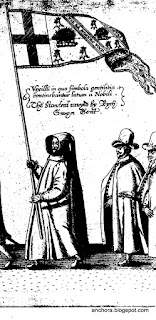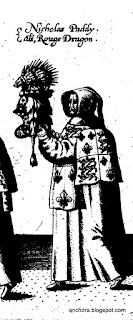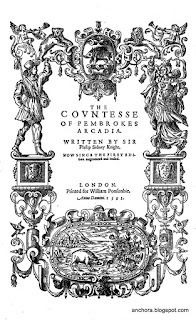The top picture is our copy of the 1633 edition of Sidney's collected works (InfoHawk catalog record here), while the second picture is our copy of Spenser's 1617 collected works (catalog record here). (Neither book is actually called the "Works" -- each is named after the longest, most epic work, the Arcadia for Sidney, and of course The Faerie Queen for Spenser -- but that is a different post altogether). As you can see, the frontispiece border on the title-page is the same; only the text has been changed. This border was initially designed specifically for the 1593 edition of Sidney's Arcadia:
The ornamental border includes several explicit allusions to Sidney and to his Arcadia: the two figures which dominate the border at the left and right are representations of the heroes of Sidney's work, Musidorus and Pyrocles, one disguised as the shepherd Dorus, the other as the Amazon named Cleophila (or Zelmane, as s/he became in the "new" Arcadia). (Margery Corbett's The Comely Frontispiece gives an excellent and detailed account of this title-page). The bear and the lion just above are an allusion to an episode from the Arcadia in which "Dorus" and "Cleophila" rescue their respective ladies, Pamela and Philoclea--or, in Corbett's words, the "animals masquerading as supporters [i.e. of the crest above] are in fact the victims of a dashing exploit carried out by the young princes to save the lives of their ladies" (61). The figure at the top is the Sidney family crest: McKerrow and Ferguson (in Title-page Borders used in England and Scotland, 1485-1640) called this a "boar passant," but it is actually a porcupine (albeit one that seems to have tusks like a boar). You can see a couple of decent images of the porcupine crest in Thomas Lant's pictorial depiction of Sidney's funeral procession, published in 1587:
 |
| STC 15224 - EEBO image |
 |
| STC 15224 - EEBO image |
Why a porcupine? In Puttenham's Arte of English Poesie, he offers one explanation of the porcupine's reputation:
King Lewis the twelfth, a valiant and magnanimous prince, who because hee was on euery side enuironed with mightie neighbours, and most of them his enemies, to let them perceiue that they should not finde him vnable or vnfurnished (incase they should offer any vnlawfull hostillitie) of suffificient forces of his owne, aswell to offende as to defend, and to reuenge an iniurie as to repulse it. He gaue for his deuice the Porkespick with this posie pres & loign, both farre and neare. For the Purpentines nature is, to such as stand aloofe, to dart her prickles from her, and if they come neare her, with the same as they sticke fast to wound them that hurt her. (Book II, Chap. XI)"Porkespick" is a variant form that derives from the French porc-espic (fitting here, for Louis XII of France), while "Purpentine" is a relatively well-known early modern English form of the word, "porpentine" appearing in Hamlet, where the Ghost describes hair standing on end to quills from the "fearful porpentine" (or "fretful," depending on which text of Hamlet one uses).
The emblem in the compartment at the bottom of the title-page once caused some confusion -- McKerrow and Ferguson don't even attempt an explanation, saying that the meaning "seems never to have been fully explained"; they simply cite the preface to Thomas Nashe's Lenten Stuffe, which is a helpful citation, even considering Nashe's characteristically ironic dedication to "Lustie Humfrey":
Most courteous unlearned louer of Poetry, and yet a Poet thy selfe, of no lesse price then H.S. that in honour of Maid-marrian giues sweete Margera[m] for his Empresse, and puttes the Sowe most sawcily uppon some great personage, what euer she bee, bidding her (as it runnes in the old song) Go from my Garden go, for there no flowers for thee dooth grow. (A2r)Corbett provides a lengthy explanation for the emblem, which shows a boar backing away from a marjoram bush, with the motto "SPIRO NON TIBI" ("I breathe out [sweet scents] but not for thee"). The general meaning is a condemnation of ignorance, that something wholesome or profitable (i.e., the marjoram bush) is perceived as poisonous by those with poor judgment (i.e., the boar). The emblem was relatively common; Erasmus, in his Adagia, included several proverbs, including this one, on a similar theme: dogs flee from baths, jackdaws from lutes, pigs from both trumpets and marjoram, and asses from lyres (the latter is Asinus ad lyram, and is an entertaining read).
It seems that the emblem was chosen by Hugh Sanford, who obliquely refers to it in his letter "To the Reader," where he defends himself and his editorial decisions. In the previous (and incomplete) 1590 edition of the Arcadia (which included only the first three books of the revised, or so-called "new" Arcadia) the "ouer-seer of the print" inserted the "diuision and summing of the Chapters," and these chapter divisions were removed in the "complete" 1593 edition, where Sanford refers to the "disfigured face ... wherewith this worke not long since appeared to the common view." The 1593 edition included the first three revised books, along with the final three books from the "old" Arcadia, an imperfect solution to the "new" Arcadia's unfinished state, which Sanford recognizes: to his credit, he calls the present edition "the conclusion, not the perfection" of the Arcadia.
Complaining of unlearned readers, Sanford writes that
To vs, say they, the pastures are not pleasant: and as for the flowers, such as we light on we take not delight in, but the greater part growe not within our reach. Poore soules! what talke they of flowers? They are Roses, not flowers, must doe them good, which if they find not here, they shall doe well to go feed elsewhere: Any place will better like them.Sanford is nominally complaining of those who might fail to appreciate the worth of the work, either stylistic or ethical--as he says, the "wortheles Reader can neuer worthely esteeme of so worthye a writing"--but this rebuke, along with the title-page emblem, could also be read as a defense of himself, one that characterizes his critics as unlearned swine.
That is certainly how it was read by Sanford's contemporaries, who interpreted the emblem as a bold and unwise inclusion: Sanford is the very "H.S." mentioned by Nashe above, whose "Empresse" [i.e., his impresa, his motto] is meant to honor his "Maid-marrian" (which here just may be a covert allusion to Mary Sidney, the Countess of Pembroke). Nashe was thus alluding specifically to the title-page border of Sidney's Arcadia. John Florio was much more forthcoming in his abuse, for in the letter "To the Reader" in his 1598 Worlde of Words, Florio fills out the initials with some new epithets: "Huffe Snuffe, Horse Stealer, Hob Sowter, Hugh Sot, Humfrey Swineshead, Hodge Sowgelder. Now Master H.S. if this doe gaule you, forbeare kicking hereafter, and in the meane time you may make you a plaister of your dride Marioram."
The title-page border was -- and was well-known for being -- specific to the context of the first edition in 1593. It was re-used for some -- although not all --of the subsequent editions of Sidney's Arcadia, which makes a lot of sense, considering the expense and trouble taken to make it. In 1611 and 1617, the border was also used on the title-page of Spenser's works, which, although it bears no specific relation to The Faerie Queene, does make sense when one considers the close connections between Spenser and Sidney. As Stephen Orgel has written, in an essay in The Renaissance Computer (on page 60):
the association of Spenser with Sidney certainly makes sense: The Shepheardes Calender had been dedicated to Sidney; The Faerie Queene is the poem that responds most clearly to Sidney's precepts in The Defence of Poetry, and if we think of Colin Clout and Britomart, shepherds and martial women are as relevant to Spenser's epic as to Sidney's romance. Sidney's coat of arms presides over Spenser's work as Sidney's writing was a model for the poet's endeavor.Due to our extended study of Sidney and Spenser this semester, the literary and intellectual connections between them became clear to my students -- indeed, perhaps too clear, considering the amount of time we spent dealing with such admittedly difficult texts. The reappearance of the title-page border would thus materially reinforce a connection that was already made, if on different grounds, by early modern readers. And it is for this felicitous connection, as well as for the inclusion of these two volumes in our collection, that I always trot out these two books during visits to Special Collections.
And yet I can't fully explain the implications of these title-pages without recourse to a PowerPoint demonstration that illustrates the title-pages of books we do not happen to own here.
In isolation, the title-page borders make a convincing case, but Sidney and Spenser are not the whole story. Just two years after the 1593 Arcadia appeared, the publisher William Ponsonby used the border again, on the title-page of a translation of Machiavelli's Florentine History:
And a few years before Matthew Lownes published the 1633 edition of the Arcadia, he used the same border for an English translation of Boccaccio:
Considering that neither Machiavelli nor Boccaccio possess anything resembling the connection to Sidney that Spenser does, Orgel is left to ponder whether the re-use of the border for Spenser's works was merely a coincidence; as he writes, "even if Lownes intended it to relate Spenser to Sidney, did any readers make the connection?" This connection would have been harder for early modern readers to make because of the existence of editions of the Arcadia that did not use the title-page border designed specifically for it. In fact, as Orgel describes here, the 1605 edition of the Arcadia (also published by Matthew Lownes) used an old title-page border originally designed for William Cunningham's The Cosmographicall Glasse, published in 1559:
This border is of course perfect for a work which deals with cosmography, but it has no relation whatsoever to Sidney's Arcadia. Even more surprising, considering the content of the border (the gods Saturn and Mercury, along with famous geographers and astronomers), it was used the very same year by Lownes on the title-page of the Sternhold and Hopkins Psalmes, which we also happen to have here at Iowa (catalog record here):
This obviously raises the question of whether this would have seemed as odd to early modern readers as it does to us -- Orgel's term is "disjunctive," since the border has no relation to the text of the book. Orgel states that the "basic point in all these instances seems to be simply that large expensive books need to have elaborate title pages," but he isn't really satisfied with that answer; he concludes his discussion by raising the nearly unanswerable question, "how did readers read title pages"? As I've already shown here, early modern readers could indeed be interested in the content of title-pages, in that case a printer's device that the owner started to cut out -- and of course this blog is named after a printer's device that carried a great deal of meaning for Erasmus, among others. I've found other evidence over the years of readers attending to the meaning or significance of title-pages, or of authors and/or printers designing title-pages, but those cases are, admittedly, few and far between: unless a reader (like Nashe or Florio) specifically describes (or even annotates) a title-page, it's difficult to know how it may have been interpreted.
There is just enough evidence in our 1633 edition of Sidney to determine that an early owner approached the book with some reverence. Across from the title-page, the owner has inserted a print of an engraving of Sidney:
If you enlarge this image, you can just make out the name "P: Stent" in the lower-left corner -- this is Peter Stent, a successful printseller in London during the civil war; since he didn't open his shop until 1642, our volume was customized some years after it was first published. This may (or may not) have been the same person who wrote the following on one of the front flyleaves of the volume: "Sr Phillip how are thy works crowned with praises," adding just below "good lord be mercyfull unto mee":
How did this early owner interpret the title-page border to Sidney's book? We cannot tell, at least not certainly, that they understood the specificity of the allusions contained within the border. But we do know that this volume (not to mention Sidney's memory) was treasured enough to warrant the insertion of an engraving, and a touchingly commemorative comment.



